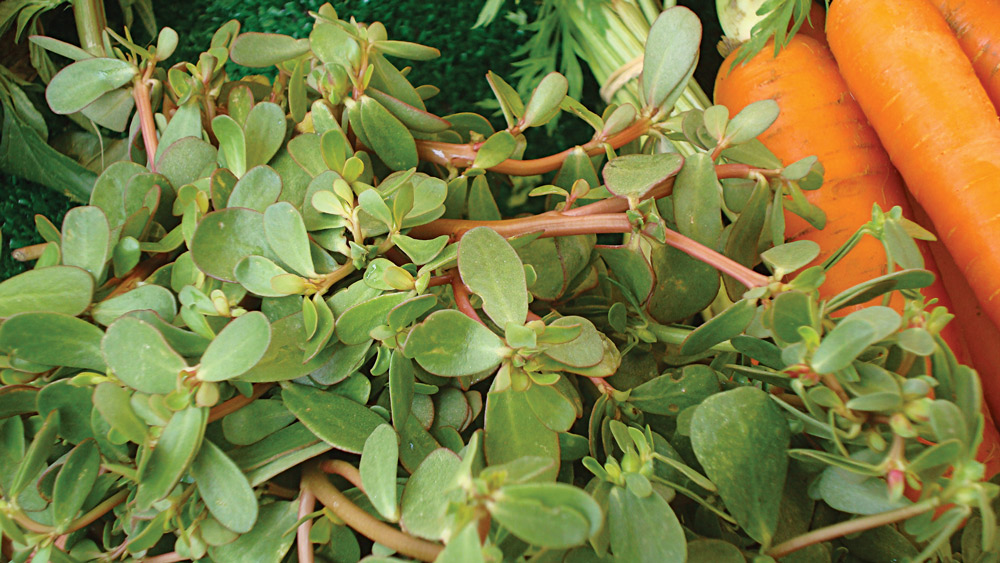PURSLANE: RAW, COOKED OR PICKLED, THIS SUCCULENT IS TASTY AND NUTRITIOUS
Name: Purslane (Portulaca oleracea)
Purslane is a member of the purslane family. According to the most recent botanical classification, this family contains only one genus, Portulaca. There are about 100 species of this genus worldwide, with purslane being one of the most common. (Formerly, purslane had been classified in the Miner’s lettuce family—a family whose members are entirely safe to eat.)
Description
Purslane starts appearing a bit later than most of the spring greens, typically by June or July. It’s a very common annual in rose beds and gardens, although I do see it in the wild occasionally, typically in the sandy bottoms around streams. The stems are succulent, red colored and round in the cross-section. The stems sprawl outward from the roots, rosette-like, with the stems lying on the ground. The leaves are paddle shaped. The little yellow flower has five petals.
Where Found
Although it’s a European native, purslane is now common and widespread in the United States. It’s found in agricultural lands, swamps, fields, gardens, ditches and vacant lots. It prefers wet soils, but it can be found in most environments.

Uses
When you chew on a fresh purslane stem or a leaf, you’ll find it mildly sour and a bit crunchy. It’s really a great snack, and I like it a lot in salads. Just rinse it to get all the dirt off, dice it, add some dressing and serve. You can also add tomatoes, avocado or other ingredients. Add purslane to sandwiches, tostadas and even on the edges of your chilis relleños and huevos rancheros. I’ve also eaten it fried, boiled and baked (in egg dishes). It’s versatile, tasty and crisp. It really goes with anything, and it’s very nutritious.
If you clean the leaves off the thick stems and cut the stems into sections of about 4 inches, you can make purslane pickles. There are many ways to make pickles; I simply fill a jar with the purslane stems, add raw apple cider vinegar and let it sit for a few weeks in a refrigerator.
Processing
Purslane leaves and stems are tender and succulent, and minimal preparation is needed. They usually need to be well-rinsed, because they sprawl on the ground as they grow. The stems and leaves are then diced into salads. The entire above-ground plant can be rinsed, diced and added to soups and stir-fries.
When to Harvest/Availability
Purslane is an annual that typically begins appearing in late spring. It can be collected throughout the summer.
Medicine/Nutrition
According to researchers, purslane is one of the richest plant sources of omega-3 fatty acids. That means that not only is it good, but it’s also good for you! According to the U.S. Department of Agriculture, 100 grams (about a half-cup) of purslane contains 103 mg of phosphorus, 39 mg of iron and 2,500 mg of thiamine, as well as smaller amounts of vitamin C, riboflavin, niacin and calcium.

Other Uses
Cultivated and horticultural varieties are often planted in ornamental gardens. This is one of the few cases for which I can recommend planting an “ornamental”—because it’s also edible.
Advice for Growing
Purslane seeds can be purchased from seed supply companies and planted in gardens or pots. The cut stems root easily, so you can cut the thicker stems that you find in the wild and then root them in good soil in your yard.

Cautions
Sometimes, common prostrate spurge plants are misidentified as purslane. Prostrate spurge, however, lies very flat to the ground; and when you break a spurge stem, a milky, white sap appears.
Recipe
PURSLANE SALSA
• 2 cups chopped tomatoes
• 2½ cups chopped foraged purslane
• 3⁄4 cup chopped onions
• 3 garlic cloves
• 1 cup raw apple cider vinegar
• ¼ cup sugar
• 1 large California bay leaf
• Salt and pepper to taste
• ½ cup chopped cilantro and some herbs from the garden (such as thyme)
Place all ingredients, except the cilantro and other herbs, into a pot. Bring to a boil and then simmer to the desired consistency (light or chunky). Add the cilantro and other herbs. Pour into jars, close the lids, and place in the refrigerator. It should be good for at least a month. (Recipe courtesy of Pascal Baudar)
About ASG’s Plant Advisor
Christopher Nyerges has been teaching ethnobotany since 1974. He is the author of Guide to Wild Foods and Useful Plants, Foraging Wild Edible Plants of North America and other books on the uses of wild plants. He can be reached at SchoolofSelf-Reliance.com.
Editor’s note: A version of this article first appeared in the August, 2020 print issue of American Survival Guide magazine.


